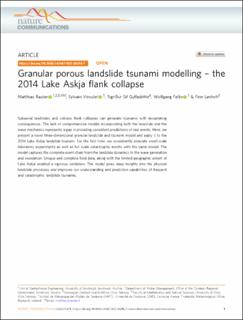| dc.contributor.author | Rauter, Matthias | |
| dc.contributor.author | Viroulet, Sylvain | |
| dc.contributor.author | Gylfadóttir, Sigríður Sif | |
| dc.contributor.author | Fellin, Wolfgang | |
| dc.contributor.author | Løvholt, Finn | |
| dc.date.accessioned | 2022-05-09T15:55:50Z | |
| dc.date.available | 2022-05-09T15:55:50Z | |
| dc.date.created | 2022-02-04T12:00:29Z | |
| dc.date.issued | 2022 | |
| dc.identifier.citation | Nature Communications. 2022, 13 (1), . | |
| dc.identifier.issn | 2041-1723 | |
| dc.identifier.uri | https://hdl.handle.net/11250/2994866 | |
| dc.description.abstract | Subaerial landslides and volcano flank collapses can generate tsunamis with devastating consequences. The lack of comprehensive models incorporating both the landslide and the wave mechanics represents a gap in providing consistent predictions of real events. Here, we present a novel three-dimensional granular landslide and tsunami model and apply it to the 2014 Lake Askja landslide tsunami. For the first time, we consistently simulate small-scale laboratory experiments as well as full scale catastrophic events with the same model. The model captures the complete event chain from the landslide dynamics to the wave generation and inundation. Unique and complete field data, along with the limited geographic extent of Lake Askja enabled a rigorous validation. The model gives deep insights into the physical landslide processes and improves our understanding and prediction capabilities of frequent and catastrophic landslide tsunamis. | |
| dc.language.iso | eng | |
| dc.title | Granular porous landslide tsunami modelling – the 2014 Lake Askja flank collapse | |
| dc.type | Peer reviewed | |
| dc.type | Journal article | |
| dc.description.version | publishedVersion | |
| dc.source.pagenumber | 13 | |
| dc.source.volume | 13 | |
| dc.source.journal | Nature Communications | |
| dc.source.issue | 1 | |
| dc.identifier.doi | 10.1038/s41467-022-28296-7 | |
| dc.identifier.cristin | 1997759 | |
| dc.relation.project | EC/H2020/721403 | |
| cristin.ispublished | true | |
| cristin.fulltext | original | |
| cristin.qualitycode | 2 | |
